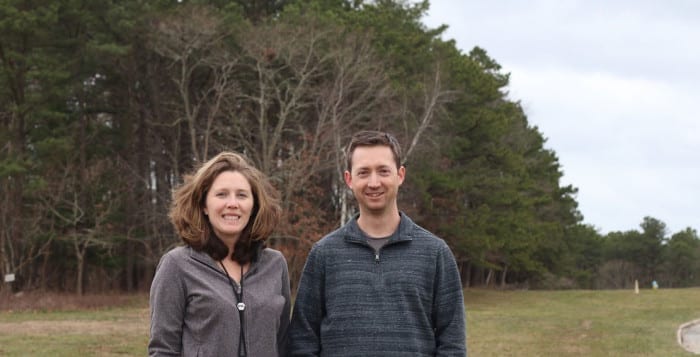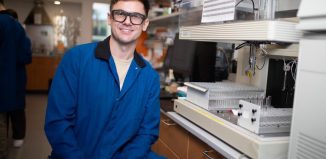BNL’s Blabys’ studies of small algae could solve big problems
Part 1 of a two-part series.
She is a “creative thinker,” while he is a “fearless experimentalist,” according to UCLA Distinguished Professor Sabeeha Merchant. Brookhaven National Laboratory recently hired the tandem of Crysten and Ian Blaby in the Biology Department.
Crysten and Ian Blaby did their postdoctoral work in Merchant’s lab for about five years. Merchant believes “there is no question that they will make discoveries to advance knowledge.”
The Times Beacon Record Newspapers will profile the scientific studies of the Blabys. This week’s column will highlight the work of Crysten Blaby, and next week’s will profile Ian Blaby.
Crysten Blaby is something of a metal worker, although she doesn’t dig anything out of the earth, wear a hard hat or ship metals by the ton. In fact, the amount of metal in her job is so small that the copper, iron, zinc and manganese she works with in a year wouldn’t fill a teaspoon.
That’s because Blaby (pronounced like “baby” with an extra letter) studies a one-celled algae called Chlamydomonas reinhardtii. This organism survives in a wide range of environments, where the amount of available metals can be precariously low, dangerously high, or can bounce back and forth between extremes.
Blaby, who is an assistant biologist at BNL, would like to know which proteins in these algae, among other species, including bacteria, plants and animals, are involved in maintaining a balance of metals.
“I am focused on the genes and proteins in metal homeostasis,” she said. That means she wants to know what genes are active in different environments.
Understanding the molecular biology of algae can provide clues about where to look for similar genes in more complex members of the plant kingdom. Discovering these processes could help farmers develop techniques that will foster growth for biofuel crops that are cultivated on lands that are less suited for food production.
“With this research, we could find easy, cheap ways to ‘diagnose’ whether crops are deficient in metal nutrients and best know how to remedy it,” she explained. “This research could also be used to help select which crops or breeds would thrive best given the quality of a particular soil.”
While Blaby won’t help produce new biofuel crops, her discoveries about the genes involved in metal homeostasis is part of “foundational science” that will underpin those types of discoveries, said John Shanklin, the head of plant science research at BNL. “Without [Ian and Crysten Blaby] doing this” the scientists who want to produce biofuel crops in inhospitable environments “are stuck.”
Blaby’s work could also help provide information that might translate into therapies for human conditions.
Menkes disease and Wilson’s disease are two inherited disorders of copper metabolism, which are caused by dysfunctional copper transporters, she said.
Blaby recently discovered a copper chaperone that looks similar to a molecule in humans and that’s involved in keeping algae safe from accumulations of copper. She suggested that the chaperone in algae protects the cell from copper by making sure that it is hand delivered between proteins. More research, however, is needed to ensure this model is accurate.
Blaby is studying the biochemical routes these metals take into the cell. The main gatekeepers controlling the movement of metal ions across membranes are likely transporters, she said.
Blaby is scheduled for beamline time at the new National Synchrotron Light Source II facility at BNL this April. The process of getting time on the beamline is extremely competitive, with numerous top-notch scientific projects rejected in part because the facility can’t yet meet the demand for a light source that is 10,000 times more powerful than the original synchrotron.
“People recognize [Crysten and Ian Blaby] are asking cutting-edge questions and they are trying to assist them in every way they can,” Shanklin said. “Everyone wants to be a part of [their] success.” After she moved to BNL, Blaby developed her NSLS-II application with Professor Emeritus Keith Jones, a physicist who she said is involved in experiments at the new synchrotron, and several of his collaborators.
“The goal is to uncover where metals travel in the cell after uptake and before they are loaded into target proteins, and understand which proteins, such as transporters, are involved” in this process, she said.
Blaby is collaborating with Qun Liu, another new hire at BNL, to look at transporter proteins, to understand how many different kinds there are, and “figure out how plants move nutrients around,” Shanklin said.
One of the ways she can solve how genes respond to different environments is by using small RNAs to knock down gene expression.
Ian and Crysten, who met when they worked in a lab in Florida, are residents of Miller Place. When they met, they were “instantly friends,” she said, in part because of their shared interest in science. They each appreciate having someone who “understands the challenges, disappointments and pure joy of discovery that comes with pursuing this career.”
The plant biologists have a two-year old daughter Emily.
As for their work, Crysten Blaby said they collaborate with each other but also concentrate on those areas where they have each developed their individual skills.
“We focus on the pathways for genes that are involved in processes that we have expertise in and where our passion lies,” she said.
This version corrects the department Crysten and Ian Blaby work in at Brookhaven National Laboratory.







